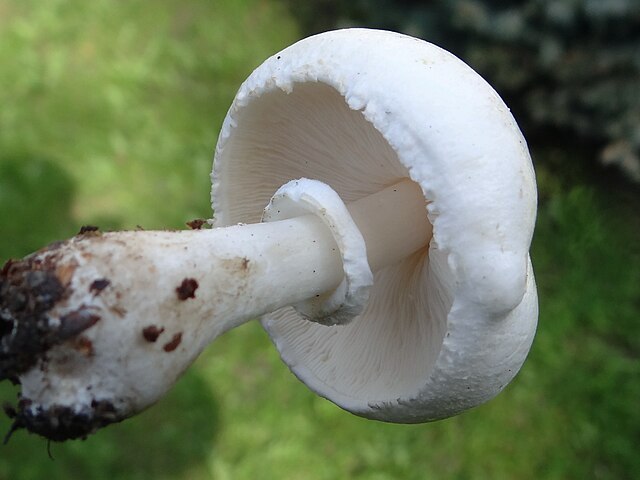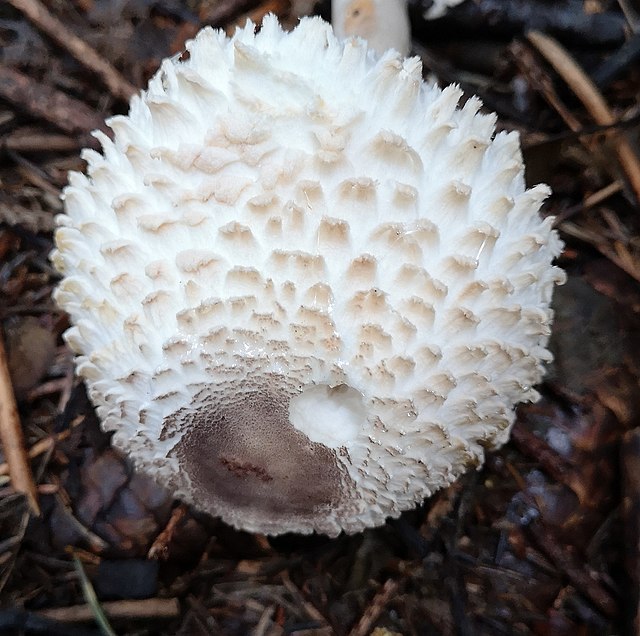Loading AI tools
Genus of fungi From Wikipedia, the free encyclopedia
Leucoagaricus is a genus of mushroom-forming fungi in the family Agaricaceae.[2] As of March 2023 there are over 200 accepted species of Leucoagaricus with ongoing research into the genus adding several more each year.[3] Leucocoprinus is a similar genus and considered by some sources to be indistinct from Leucoagaricus based on genetic data that demonstrates they are monophyletic. Species are separated into these genera based on macroscopic features such as cap striations in Leucocoprinus or the more persistent basidiocarps (mushrooms) of Leucoagaricus as well as microscopic features such as the lack of a germ pore in Leucoagaricus species.[4][5] As a result of the similarities and disagreement on taxonomy, many of the species within these genera have formerly been classified in the other and may still be known by previous classifications. For instance the species Leucoagaricus gongylophorus is cultivated by fungus-growing ants but was formerly known as Leucocoprinus gongylophorus whilst other species cultivated by the lesser attine ants are still classified as undescribed Leucocoprinus species.[6]
| Leucoagaricus | |
|---|---|
 | |
| Leucoagaricus americanus | |
| Scientific classification | |
| Domain: | Eukaryota |
| Kingdom: | Fungi |
| Division: | Basidiomycota |
| Class: | Agaricomycetes |
| Order: | Agaricales |
| Family: | Agaricaceae |
| Genus: | Leucoagaricus Locq. ex Singer (1948) |
| Type species | |
| Leucoagaricus macrorhizus Locq. ex Singer (1948) | |
| Species | |
| Synonyms[1] | |


This group of mushrooms was first defined as a subgenus of Leucocoprinus by Marcel Locquin in 1945, and it was then elevated to the status of genus by Rolf Singer in the journal Sydowia in 1948. The group was characterized as belonging to family Agaricaceae with white, dirty cream or pink spores which are generally small (up to 10 μm) but much bigger in one species, with a germ pore, with a pseudo-amyloid multilayered membrane, simple or ornamented, which is metachromatic in cresyl blue. The hyphae in the sporocarp are without clamp connections. There is always a ring which is initially fixed (but later may be movable).[7]
The type species is Leucoagaricus barssii (Zeller) Vellinga, which was formerly called L. macrorhizus.
The genus Sericeomyces was created in 1978 by the Belgian mycologist Paul Heinemann to accommodate species with a silky covering to the cap[8] with 24 species being placed within this genus having been reclassified from Lepiota.[9] However this classification has since been rejected as phylogenetic data demonstrated they were not distinct from Leucoagaricus.[10]
The genus is further divided based on its morphology with the section classifications:[4]
Select species include:
Seamless Wikipedia browsing. On steroids.
Every time you click a link to Wikipedia, Wiktionary or Wikiquote in your browser's search results, it will show the modern Wikiwand interface.
Wikiwand extension is a five stars, simple, with minimum permission required to keep your browsing private, safe and transparent.